
Brian Patrick O'Donohue
Tom Robbins and Annette Fuentes, City Limits' editing team in the early 1980s, in the magazine's offices.
THE SAVING OF 414 WEST 48th STREET
WHAT IS REDLINING? (Answer: Redlining is a white collar crime.)
SOUTH BRONX SNUBBED ON REDEVELOPMENT PLAN
The headlines were forceful, printed in capital letters. They came from a publication that spoke to its times.
In 1976, New York City’s neighborhoods were facing crushing challenges unlike any they had seen before. The city’s fiscal crisis had left New York with few resources and a growing sense of doom. In many neighborhoods, arson and abandonment of apartment buildings were becoming everyday occurrences, as some property owners determined that their real estate was worth more in insurance proceeds than it was for its rental income. By the summer of 1977, more than 20,000 buildings in New York would be abandoned. At the end of that year the city owned 6,000 buildings and was poised to foreclose on 25,000 more.
Yet pockets of hope took hold in besieged neighborhoods across the city. With the support of community groups, tenants were taking charge of their buildings as their landlords abandoned them. The earliest of these efforts had won the backing of the administration of Mayor John Lindsay, which created the city’s first nonprofit management programs for in rem buildings that had been taken over by the city for nonpayment of taxes. An Upper West Side lawyer named Robert Schur was the official in charge for the city. Then Roger Starr, a deputy to new mayor Abe Beame, took charge of the city housing agency. Starr’s agenda of “planned shrinkage”—the withdrawal of public services from distressed neighborhoods—was the antithesis of Schur’s vision of community rebuilding. Starr fired Schur.
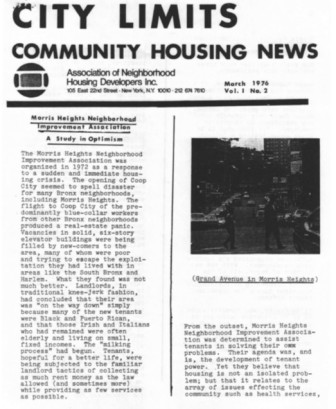
March 1976
Schur could have taken a job in the private sector. Instead, he helped found the Association of Neighborhood Housing Developers (ANHD), a member organization for many of the community housing organizations he had worked with at City Hall. Private sector investment in New York City housing had virtually dried up, and ANHD members did what they could, with minuscule resources, to fill the void.
Like any group looking to inform and motivate members, ANHD published a newsletter. It was called City Limits.
Under Schur and Editor Kathy Sanders, City Limits was born to tell ANHD members how to obtain funding for repairs or to hire community organizers, and it explained the often impenetrable intricacies of government programs and the real estate business. It told members about important meetings. City Limits informed the tenants who were taking over abandoned buildings, or reclaiming their own, how to weatherize their homes, obtain low-cost fuel, tap into job-training programs and secure loans. It helped those working to stabilize neighborhoods learn about what one another were doing.
But Schur also created something much more than a newsletter. From the beginning, City Limits kept close watch on City Hall. When Mayor Beame sought to use New York’s federal Community Development Block Grant to bail out the city’s budget, Schur made sure his readers knew it. Schur launched a series that reflected a chronic challenge for its readers: Called “Lingo,” it deciphered the cryptic lexicon of housing and property law.
In September 1978, two of Schur’s allies—Ron Shiffman at Pratt Institute Center for Community and Environmental Development and Philip St. Georges at the Urban Homesteading Assistance Board—decided that their organizations and the movement would be better served if they took the funds they were spending on their own publications and merged them with ANHD’s. Each organization would contribute $5,000 each year. City Limits, they agreed, would function as an independent enterprise, without editorial interference from its sponsors. Schur and his co-sponsors believed strongly that the movement needed its own watchdog.
“We decided that even if it attacked us, we wanted an independent voice,” says Shiffman, who is now retired as the Pratt Center’s director. “We wanted an advocacy voice that would hold us all accountable.” by Alyssa Katz
In 1980, Lower East Side community organizer Tom Robbins saw an ad in City Limits seeking an associate editor. “There were such amazing things going on in the Lower East Side,” remembers Robbins, who is now a professor at the CUNY Graduate School of Journalism. “Landlords would step out the door and torch their buildings.” Robbins needed a break from the organized criminals who were an ominous and sometimes violent adversary in the neighborhood. City Limits’ tiny office on 23rd Street—and the $12,000 salary, the most he had ever been paid—provided a new opportunity to carry on the work.
While City Limits’ voice was often a radical one, it was always rooted on an utterly pragmatic sensibility. Aggrieved by the darkening climate of the Reagan revolution and rapid disinvestment in community development programs, Schur took to the pages of City Limits in early 1982 to write an angry, stark and seminal piece: “Back to Basics: Organizing in the Age of Austerity.” Schur maintained that there was no way to resurrect poor neighborhoods without strong support from government, and he saw community organizing as the only way to make it happen. “Government provides benefits for the poor, minorities and disadvantaged, not because they love them, but because they fear them,” Schur wrote.
Schur died soon after the article’s publication. The editors and writers who succeeded Schur believed urgently in the value and power of city neighborhoods that were continuing to be written off as hopelessly dysfunctional.
They also had to deal with new challenges. Robbins, Annette Fuentes and their colleagues in the early 1980s quickly confronted a vexing story: mass homelessness. The concept was a new one, and needed explanation and assessment. What could the community development movement do? How could the city provide emergency shelter to the swelling number of families and single men and women who needed it, while maintaining critical investments in permanent housing, all in the face of federal cutbacks? City Limits serialized a report from pioneering homelessness experts Kim Hopper and Ellen Baxter, and followed it up with relentless reporting on New Yorkers driven out by demolition or co-op conversion of their homes.
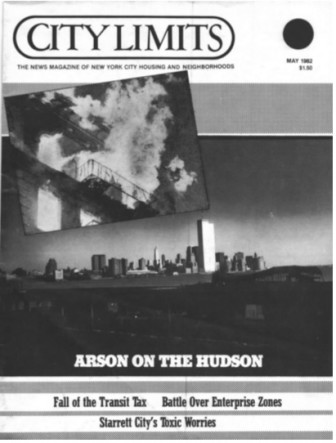
May 1982
The story of displacement emerged in other ways too. In 1984, Robbins wrote a shattering series about the actions of property holders in Crown Heights and Borough Park, who were harassing longtime tenants in order to clear buildings and development sites for Hasidic families. The series was controversial, and Robbins had to contend with accusations of anti-Semitism. But Robbins’ work established City Limits as a vehicle for serious journalism. Not incidentally, the City Limits of that era spawned other major journalists, including Michael Powell, a former community organizer who is now a New York Times columnist, and Jill Nelson, best known for her book attacking discrimination at the Post and other newspapers.
But much of the work of making City Limits was mundane. Robbins and Fuentes put mailing labels on the magazines and schlepped them to the post office. And of course, they raised the money. City Limits and local banks settled into a productive relationship. The federal Community Reinvestment Act of 1977 proved not only a critical lifeline for homebuyers and neighborhood housing groups, but also a conduit for support of City Limits. During the 1980s, financial institutions provided increasing levels of support to the organization, a relationship that sometimes raised friction when articles were critical of financial institutions’ practices.
At the same time, the magazine began to take a broader look at the forces holding city neighborhoods together. In 1985, Fuentes profiled LL Cool J, a skinny kid in a funny hat from Hollis, and part of a thriving Queens music scene. “They were playing in their yard. One guy would bring a boombox and another would bring a turntable. This is what happens in neighborhoods—not just that people have houses, and get evicted from housing,” says Fuentes, now a freelance writer. “What City Limits could bring was an integrated perspective.” -Katz
As the 1980s progressed, City Limits more and more frequently looked beyond bricks and mortar and delved into other forces that shaped neighborhood life. Doug Turetsky, who had first discovered City Limits at a Park Slope newsstand, provided critical insight into economic development, jobs programs and the redevelopment of Long Island City. Other stories put new issues on the map, including environmental justice, recycling and waste management, and community input in the city planning process.

May 1986
Lisa Glazer, who later became the magazine’s editor, exposed State Senator Pedro Espada’s misuse of government funds at his Soundview Health Center. Turetsky sent freelancer Eve Heyn undercover to a trade school, and together they exposed the school’s double-edged shakedown: of government student aid programs, and of the students, who were lured with promises of lucrative employment. City Limits, of course, also continued to cover housing, notably the Koch administration’s 10-year plan for housing development, the warehousing of apartments for co-op conversions and landlords’ abuse of Freddie Mac loans. The increasing diversity of the stories in City Limits arose in part from the ambition of the young staff, who sought to tell important neighborhood stories that couldn’t be found in other New York media. Ultimately, the expansion of the magazine into arenas beyond housing was fueled by the sense that the range of stories was essential reading for their core audience of community developers.
Glazer and then her successor as editor, Andrew White, continued the magazine’s now-established tradition of muckraking reporting. Glazer and White revealed execrable conditions in the Emergency Assistance Unit, the intake center for homeless families. Jill Kirschenbaum, now an editor at the Wall Street Journal, took on the woeful lack of drug treatment for women during the crack epidemic and the plight of incarcerated mothers. Glenn Thrush investigated a contractor who used his political connections to shake down East New York community development groups. (Thrush is now a reporter for Politico.)
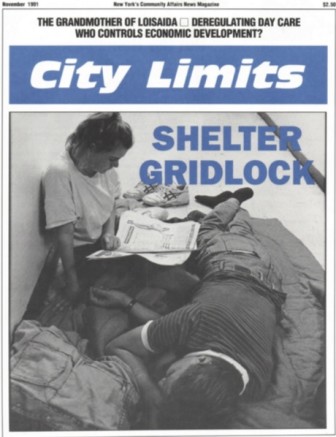
November 1991
With White and freelancer Jesse Drucker (now at Bloomberg), future Executive Director Kim Nauer reported on the crimes of Harlem slumlord Baruch Singer, who later faced heat for his investment in the Greenpoint waterfront warehouse that burned in a massive blaze. White wrote a series on the painstaking effort to transfer derelict federally subsidized apartment buildings to organized tenant groups. Pretending to be suicidal, Kevin Heldman checked himself in to Woodhull Medical Center’s psychiatric unit and returned seven and a half days later with a harrowing account of his treatment there. -Katz
But by 1995, White grew concerned that something was missing. The magazine was succeeding in exposing problems and in profiling organizations offering innovative solutions, from worker-owned cooperatives to supportive housing. Yet the organization didn’t have the capacity to provide another essential resource: groundbreaking ideas and analysis that weren’t already in play in New York. As Congress, New York State and City Hall slashed the budgets of programs neighborhoods depended on, it was clear that New York City needed a local generator of new ideas and action. Thus the Center for an Urban Future was born.
“The idea of the Center for an Urban Future was to be akin to the magazine in the way it was digging around for good stuff and sharing it with the world,” says White, who is now an official at the Administration for Children’s Services. “We had no sense of limiting what we were going to cover, other than improving the standard of living in low-income neighborhoods.”
The Center for an Urban Future’s first project looked at the possibilities of a community-centered, results-oriented strategy for juvenile justice, at a time when the Giuliani administration focused strictly on putting offenders in jail. Its second project, Child Welfare Watch, grew from City Limits’ 1995 investigation of chaos at the city’s child welfare agency, where piles of lost case files were just the most visible sign of an agency that had lost track of its young charges. Budget cuts had devastated the agency, even as the crack epidemic sent thousands more children into foster care. City Limits’ special report was published shortly before the murder of 6-year-old Elisa Izquierdo by her mother, and it helped make the case for reconstituting the Administration for Children’s Services as a separate city agency. Child Welfare Watch then stirred controversy with its second issue, in 1998, which asked: Why were 97 percent of children in foster care black or Latino?

June 2000
The same grant from the New York Foundation that established the Center for an Urban Future in 1996 also launched the City Limits Fax Weekly, distributed right into the offices of the city’s community groups and leadership. The weekly publication schedule allowed City Limits to track news it never had before. It was a heady time. The Giuliani administration was ending repossession of in rem property and replacing it with innovative but complex new programs that asked community development groups to work in new ways. The fax, soon expanded onto the Internet, gave the organization an unexpected boost as well: an explosion of classified advertising. With no marketing, City Limits quickly became what it remains today, the necessary place to advertise for community-serving organizations looking to hire top talent. But the Weekly always operated as a high-impact editorial project. Founding Weekly editor Kierna Mayo, followed by Thrush, Kathleen McGowan, JilI Grossman and Cassi Feldman, worked exhausting hours to develop breaking stories on deadline and then lay out and distribute the Weekly every Friday night.
The month Alyssa Katz became editor of City Limits in 1999, Associate Editor Kemba Johnson went on assignment for the City Limits Weekly to investigate why a Long Island nonprofit for the mentally retarded had bought an SRO building in Harlem and sent in a demolition crew with orders to kick out aII the men who lived there. By the end of the summer, when she didn’t have to take breaks to type up the burgeoning number of job ads for the Weekly, Johnson had uncovered a major real-estate fraud scheme that had tapped tens of millions of dollars from the insurance fund of the Federal Housing Administration and left Harlem and eastern Brooklyn littered with foreclosed and abandoned homes. City Limits tracked the 203(k) debacle from the beginning, as tenants struggled to get basic services and repairs and then organized to win federal funds to reclaim the buildings. The scandal even inspired a plot line on The Sopranos. And City Limits was there when, five years after the scheme began, the city and nonprofit community development groups began to sell restored 203(k) homes to new owners. -Katz
As City Limits was about to go to press on its 25th anniversary issue and the Center for an Urban Future had just put to bed its first work on arts and economic development, our own neighborhood came under siege. The World Trade Center was just eight blocks from our offices, and many staff had fled that morning. When we could get back into the office a week later, it was with a mix of grief, confusion and a sense of new purpose. For more than a year after September 11, the New York City media was preoccupied with one story. City Limits got to work covering the city neighborhoods that the rest of the New York media suddenly forgot.
A 19-year-old intern was the first New York journalist to write about school “push-outs”-failing students forced to leave high school. Katz edited a series about a sweetheart deal with the Giuliani administration to build a luxury golf course in a Bronx park. Senior Editor Annia Ciezadlo, who launched a new section of the magazine exploring ideas and innovations, documented horrendous working conditions for laborers on affordable housing projects and looked at the persistence discrimination in the construction business.
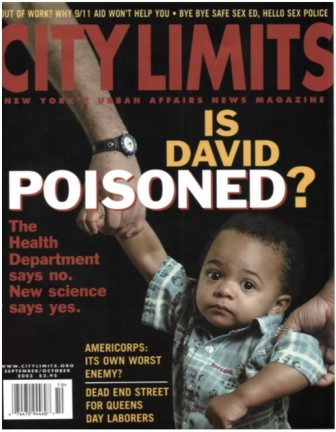
September/October 2003
Senior Editor Feldman explored a booming but unregulated underworld of halfway houses for people with mental illness; in the Weekly, she chronicled controversial developments in the city’s homelessness policies. Managing Editor Tracie McMillan, in between production deadlines, wrote a comprehensive series explaining the shattered infrastructure of supports for New York’s low-income families and young people. Her articles also profiled innovative solutions, such as a project that trained young people to be community leaders in nutritious eating. McMillan’s work was representative of a broad and ongoing commitment to document best practices and the dedicated work of those committed to building stronger neighborhoods. -Katz
A mission to cover the neighborhoods and stories neglected by the for-profit press entails, by definition, figuring out how to pay for journalism that the market won’t support. Against those odds, City Limits has survived for 40 years thanks to generous supporters, a pool of principled and dedicated writers, and the indispensable contribution of sweat, imagination and luck.
Sometimes, however, the pressures became truly perilous. By 2006, financial problems and institutional growing pains had forced City Limits magazine into hibernation and reduced the staff to a single employee, web editor Cassi Feldman, who later passed the torch to Karen Loew. Under new executive director Andrew Breslau, later the head of the Nation Institute and now a vice president at the Downtown Alliance, City Futures began rebuilding its media arm the following year, relaunching the magazine as a quarterly, long-form investigative publication that devoted each issue to a deep exploration of an important topic, from the impact of rising construction costs on Mayor Bloomberg’s affordable housing plan to combined sewage overflows. Breslau hired me to run the relaunched magazine.
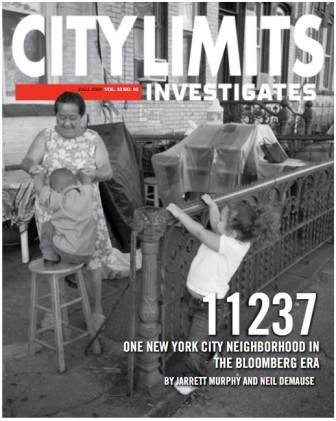
Fall 2009
With its return to print, City Limits moved aggressively to gain a higher profile. Staff set out with “newsie” bags on each publication day to get the new magazine into the hands of columnists and editors around the city, and Breslau struck content-sharing deals with publications like City & State and AMNewYork. The magazine published deep, probing work about the drug war and public housing, and the website was the first to raise questions about the CityTime project and some of Mayor Bloomberg’s housing and welfare policies.
But the 2008 financial crisis again began to eat into City Limits’ base of support, and it soon became clear that the outlet needed a strong, institutional host to foster the kind of growth that would make it sustainable. In late 2009, City Limits became a project of the Community Service Society of New York, an organization that has been fighting poverty in New York since 1843 and wanted to support independent reporting on matters of economic and social justice.
“City Limits is unique in that it produces the kind of investigative journalism on issues impacting low-income communities not found in mainstream media,” said CSS CEO and president David Jones. “It is a voice on urban policy that we felt needed to be preserved, and CSS was proud to be a bridge for it on its way to becoming a financially-independent entity.” -Jarrett Murphy
Thanks to unwavering support from the CSS board and staff and the creativity of publisher Mark Anthony Thomas, City Limits began a period of rapid growth, with a redesigned website, a full-color magazine that published bi-monthly and a bigger reporting budget. A typical project was the richly nuanced investigation that deputy editor Kelly Virella and a team of interns—a frequent source of the inspiration and perspiration that has kept City Limits going—produced about sexual abuse at New York State’s women’s prisons. It nabbed the national Society of Professional Journalists’ Sigma Delta Chi award for best investigation by a local or regional magazine in 2011, an honor that City Limits had also won the previous year for an exposé of problems with synthetic turf in city parks.
As has been true for virtually every media outlet, the growing power of the Internet created interesting opportunities and forced difficult choices for City Limits. In 2012, the organization launched a separate web product called Brooklyn Bureau to focus reporting on the borough that was increasingly at the center of New York City’s larger story. In 2013, after taking over the defunct Bronx News Network, City Limits launched a companion Bronx Bureau. The expansion was part of a broader evolution: After 36 years, the magazine stopped publishing for good in 2012. The Bronx and Brooklyn reporting lines eventually became part of a redesigned website that launched in late 2014.
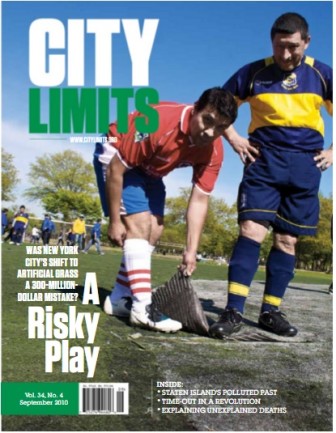
September 2010
The relaunch was just one huge shift that year: In July 2014, under a long-standing plan, the Community Service Society and City Limits separated. For the first time since the formation of CUF nearly 20 years earlier, City Limits was on its own.
Yet, it was hardly alone, with partners in the national and local media who supported and promoted City Limits’ work. City Limits blogged about Mayor de Blasio’s first 100 days for The Nation, began a regular weekly appearance on WBAI and partnered with BRIC-TV to moderate a bar-based reporter roundtable show called “Straight Up.” Our reporters appeared more frequently on NY1 and the Brian Lehrer Show, and were increasingly invited to handle the gavel at candidate debates and policy panels. Partnerships with Gotham Gazette, Gothamist, NYWorld, The Lens of New Orleans, Detroit Metro Times and others helped set the stage for our 2015 “Cost of Water” series with WNYC, a multi-part investigation of the city’s drinking water system.
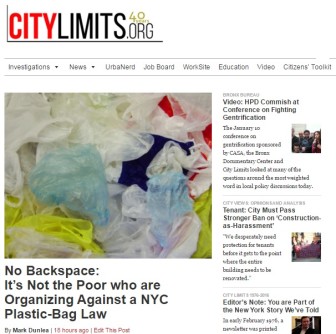
The all-digital City Limits, February 2016
As 2015 ended and 2016 began, it has been increasingly clear that the struggle for economic and social justice in New York—the story City Limits was founded to cover—is now front-page news, with topics like income inequality, homelessness and problematic policing dominating the civic debate. And there was visible proof of the kind of impact our journalism can have when Johnny Hincapie, imprisoned since 1990 for a crime he says he didn’t commit, walked out of a Manhattan courtroom to embrace his mom and dad after a judge tossed his conviction. The long road to that decision had begun with a City Limits article in 2010. -J. Murphy
Sometime it’s easier to write a 15,000-word investigative story than a short, punchy tag line. I know this because, at many points during my nine years here, City Limits has thought and talked–and thought and talked some more—about how best to explain exactly what we are. Investigative. Non-profit. Urban. Progressive. Those words have been strung together on many a sheet of scrap paper.
But I keep coming back to the phrase that was on a piece of early marketing material we found in the archives and posted on our office door: “City Limits. We Cover the Other New York.”
Over the years, some have told me they find that old slogan self-ghettoizing, divisive, antiquated. But I think the journalism to which the line refers refutes those critiques. City Limits was established not to catalog victimhood but to chronicle, and inform, the work of marginalized residents to overcome their relegation. Our message has always been that there is just one city, and therefore that we ignore at our common peril the parts of it that are poor, brown, gay, immigrant, disabled, or otherwise separated from entrenched power. And no one knows better than our reporters and our sources that a lot has changed in the city since February of 1976. We saw it at street level.
What hasn’t changed—and never will—in this massive and fascinating city is that there is a bigger, deeper story than the one you already know. Four decades in, City Limits is still chasing it. -J. Murphy









